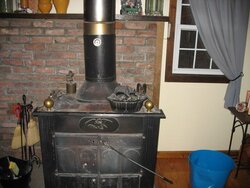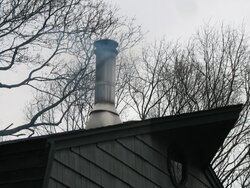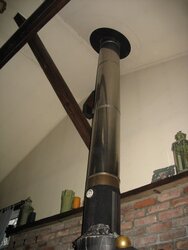i am going to be installing a woodstove this spring. i found a guy selling 18 feet of new stainless chimney pipe for a steal. this is enough for me to do the complete install. is there any harm in using this stuff all the way to the flue? i was originally going to use black double wall stovepipe inside and the stainless chimney outside, but i came across this. any harm in using the stainless throughout?? i imagine i may get a bit less heat inside due to the insulation of the stainless pipe, but i doubt it would be noticable. what do you guys think?
Chimney Pipe or Stove Pipe???
- Thread starter linckeil
- Start date
-
Active since 1995, Hearth.com is THE place on the internet for free information and advice about wood stoves, pellet stoves and other energy saving equipment.
We strive to provide opinions, articles, discussions and history related to Hearth Products and in a more general sense, energy issues.
We promote the EFFICIENT, RESPONSIBLE, CLEAN and SAFE use of all fuels, whether renewable or fossil.
You are using an out of date browser. It may not display this or other websites correctly.
You should upgrade or use an alternative browser.
You should upgrade or use an alternative browser.
- Status
- Not open for further replies.
Hogwildz
Minister of Fire
linckeil said:i am going to be installing a woodstove this spring. i found a guy selling 18 feet of new stainless chimney pipe for a steal. this is enough for me to do the complete install. is there any harm in using this stuff all the way to the flue? i was originally going to use black double wall stovepipe inside and the stainless chimney outside, but i came across this. any harm in using the stainless throughout?? i imagine i may get a bit less heat inside due to the insulation of the stainless pipe, but i doubt it would be noticable. what do you guys think?
Is the stainless insulated double or triple wal? Or single wall? If double or triple, a full run of it should be fine.
jtp10181
Minister of Fire
That kind of pipe is not meant to be inside the dwelling area unless enclosed in a chase. You should use the HT pipe for the flue system and connector pipe (single or double wall) inside the room with the stove.
why is that? i know it is designed for exterior use, but what is the harm with using the pipe inside the room? thanks.
keyman923
Member
Any idea of the brand of pipe and calling the manufacture and asking them? When I asked about this when I was going to run triple wall inside I was told it wasn't allowed but never got a good answer why, I hate the look of 7-13' of 6" single or double wall on a cathedral ceiling, to me it just looks wimpy, it has to be safer to run triple wall off the stove. Its probally like running the better quality canadian pipe in the USA, safer but not allowed yet.
Here's a pic of 7'8" of single at my home, I think it looks like ass.
Here's a pic of 7'8" of single at my home, I think it looks like ass.
Attachments
thats a good thought, maybe i will put in a call. i can't imagine it would be against code, being that the clearance to combustibles is 2" as opposed to 6" for double wall pipe and 18" for single wall pipe. if anything, i'd imagine it would be encouraged.
maybe having the chimney pipe both outside and inside promotes increased creosote formation? i have no clue.... but i'd love to know any reasons why it wouldn't be a good idea.
maybe having the chimney pipe both outside and inside promotes increased creosote formation? i have no clue.... but i'd love to know any reasons why it wouldn't be a good idea.
keyman923
Member
If anything I would think the triple wall would reduce cresote, seems to me that I get the most cresote where the chimney exits the roof and is exposed to cold air, plus anything that would be exposed to the triple like drywall would be less likely to get burned. This 18" clearance on single wall I really don't get, ok maybe if your running some old pre epa stove with the doors removed and are constantly running a 900+ flue temperature,,the 2" at the roof I understand, I always thought most cresote fire's happen at the roof line?
Metal
Minister of Fire
- Nov 18, 2005
- 701
People use black pipe because it is smaller (diameter wise) and prettier and it puts more heat into the structure instead of up the flue. There are no codes I know of that say you can't put 103HT pipe all the way to a stove. The only issue I would have with it is how it adapts to the stove since most manufacturers don't have a stove adapter that fits directly to 103HT pipe so you may have to rig something. If you end up doing this please post pictures of the finished product.
here are some pics of the setup of someone that i know. it is stainless chimney pipe all the way, like i'm considering. this setup was inspected and approved about 25 years ago. exactly how it was attached to the flue is not remembered - and you can see there is black pipe covering that area.
Attachments
thechimneysweep
Minister of Fire
There is no code prohibiting the use of double- or triple-wall chimney all the way to the stove: in fact, until double-wall connector pipe was invented just a few years ago, ALL woodstove installations in manufactured homes were required to have chimney pipe all the way.
Which is one reason why the double-wall connector pipe was invented. The chimney section closest to the stove would sometimes buckle due to the trapped heat. This wasn't an epidemic, but we did see it a few times in our service area in installations using solid pack double-wall chimney. I wouldn't be concerned about buckling with the triple-wall.
To make the connection to the flue collar, use the part the manufacturer offers to make the connection from the chimney to stove pipe. For 6" chimney, Security Chimney calls it a 6UP, Duravent calls it a pipe-chimney adapter (part #8674).
Which is one reason why the double-wall connector pipe was invented. The chimney section closest to the stove would sometimes buckle due to the trapped heat. This wasn't an epidemic, but we did see it a few times in our service area in installations using solid pack double-wall chimney. I wouldn't be concerned about buckling with the triple-wall.
To make the connection to the flue collar, use the part the manufacturer offers to make the connection from the chimney to stove pipe. For 6" chimney, Security Chimney calls it a 6UP, Duravent calls it a pipe-chimney adapter (part #8674).
thechimneysweep said:The chimney section closest to the stove would sometimes buckle due to the trapped heat. This wasn't an epidemic, but we did see it a few times in our service area in installations using solid pack double-wall chimney. I wouldn't be concerned about buckling with the triple-wall.
a quick follow-up on this point... so it would buckle due to the metal expansion caused by the heat? in all my research, i haven't read anything about metal expansion on the stove or chimney pipe. and all the brouchere's i've seen have not addressed it. i'd imagine there would have to be some kind of an expansion joint in the system, but again, i haven't seen anything like that. is metal expansion due to heat even something i should be considering??
thechimneysweep
Minister of Fire
It's what happens to all manufactured chimneys eventually, due to exposure to heat over time. The inner liner gets bulgy in spots, interfering with the draft, and eventually holes develop. We quite often see buckling after a chimney fire. In normal operation, the bottom section, right at the stove, is always hotter than the rest of the chimney, so it ages (and buckles) faster: think ten years instead of 20+. Triple-wall, or air insulated, chimney doesn't seem to trap as much heat in the inner liner as solid pack does; at any rate, we haven't seen any premature bottom-section buckling with triple-wall.
- Status
- Not open for further replies.
Similar threads
- Replies
- 13
- Views
- 822
- Replies
- 0
- Views
- 364
- Replies
- 27
- Views
- 2K
- Replies
- 13
- Views
- 960




